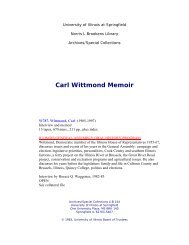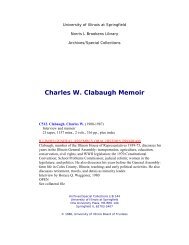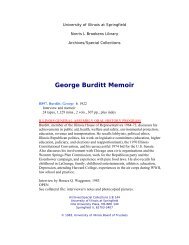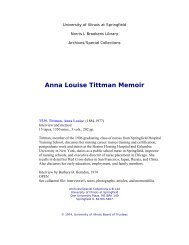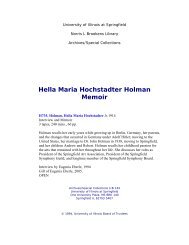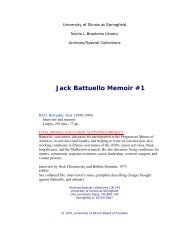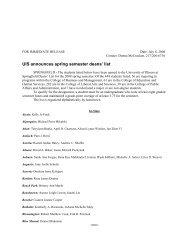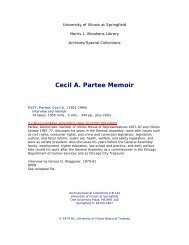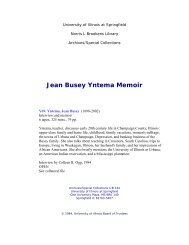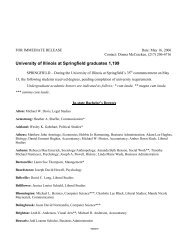Leland J. Kennedy Memoir - University of Illinois Springfield
Leland J. Kennedy Memoir - University of Illinois Springfield
Leland J. Kennedy Memoir - University of Illinois Springfield
You also want an ePaper? Increase the reach of your titles
YUMPU automatically turns print PDFs into web optimized ePapers that Google loves.
een that far back, in that era, maybe 1904, and 1905, and 1906, in there, and sold stock<br />
for that company to the employees.<br />
Q: I'll be darned.<br />
A: Of course they had to buy it but real real cheap.<br />
Now how the glassworks was organized I don't know, but I know this: the glassworks had<br />
an <strong>of</strong>fice in St. Louis and their executives would go down on a boat. Now there must have<br />
been, besides those steamers, daily transportation between Alton and St. Louis. In those<br />
days. Of course there was train service and interurban service, but I guess for the people<br />
that could travel leisurely, that could get on a packetboat and go down to - there always<br />
was a lot <strong>of</strong> river traffic, not so much barge traffic, they hadn't thought the barges yet. But<br />
the river traffic, oh, there was always a lot <strong>of</strong> river traffic.<br />
By the way, when I - <strong>of</strong> course this is closer back to the 1930's again, I told you that 1<br />
went to work for Shell in 1927 - I worked in what they called the light oil treating<br />
department. We were just operating engineers. That was our <strong>of</strong>ficial title. That was the<br />
union we belonged to. And we handled the transportation <strong>of</strong> gasoline. And we loaded<br />
barges, I suppose the first barges were loaded in this area. This is quite a barge center<br />
now you know, down in the marine terminal down in Hartford on the Mississippi River. If<br />
you go down Route 3, you'll go by and you'll see signs pointing to the barge traffic. I think<br />
the Shell refinery and the Clark refinery, and I believe that there's another refinery comcs<br />
in there - one <strong>of</strong> these, that one over in Robinson has a barge terminal there. They load<br />
a lot <strong>of</strong> petroleum products, mostly gasoline I guess, but they load asphalt and barges and<br />
there are some oil barges. I think it's one <strong>of</strong> the largest barge terminals on the Mississippi<br />
River outside <strong>of</strong> New Orleans, that down at Hartford, or Hartford Terminal I think they<br />
call it.<br />
Q: Now does that traffic go north and south or .<br />
A: It goes both ways. If you have ever noticed it, and wondered why, if you see a petroleum<br />
barge, when it's full, it's just almost level with the water. If you see one that's sticking<br />
up, maybe seven or eight feet, it's empty. And <strong>of</strong> course coal and steel are loaded on barges<br />
now too. Laclede Steel's got a barge landing. Laclede Steel was here <strong>of</strong> course. I failed<br />
to mention them, and I think that, if you've noticed, you mentioned about going to Mount<br />
Vernon, there's always those hundred plus coal cars going through here.<br />
Q: Yes.<br />
A: Route 3, they're going north, or you see them deadheaded back, they're going up, I guess,<br />
to Commonwealth and Edison or Northern <strong>Illinois</strong> Gas up there with their coal, I would<br />
think that's where they'd be going. Maybe they're going west out to Kansas City, which<br />
probably some <strong>of</strong> them do go that far. I imagine that Union Electric plants - there's a<br />
couple along the Mississippi and I guess they get their coal that way. I've never paid that<br />
much attention, but you see them going through. Hell, when I rode the train to <strong>Springfield</strong>,<br />
you'd get to see them all the time. Because they'd be on the siding, they'd get on the siding<br />
for a passenger train, but if they were ahead <strong>of</strong> a passenger train, you had to follow them<br />
until they got to a siding.<br />
Q: Well.<br />
A: Because we were - oh, I've been delayed numerous times out at the cut<strong>of</strong>f stations -<br />
C & A, I call it the cut<strong>of</strong>f, it's the <strong>of</strong>ficial station - because there's a coal train ahead <strong>of</strong><br />
you, see? But they'd get to the siding around Carlinville or there's a couple - there's one<br />
up around - well just south <strong>of</strong> <strong>Springfield</strong> - what are some <strong>of</strong> those towns, Waverly?



